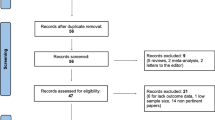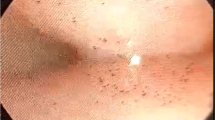Abstract
Despite the numerous progresses in the palatal surgery, one of the critical aspect of snoring and OSA surgery is the postoperative pain. Over the last decades several surgical palatal procedures have been proposed. Our aim was to evaluate the tolerability of the coblation-assisted barbed anterior pharyngoplasty (CABAPh) in terms of postoperative pain and wound healing, compared with bipolar assisted barbed anterior pharyngoplasty (BAPh). An observational study on 20 patients with simple snoring was conducted. The outcomes measured to assessing pain were a 10 cm visual analog scale (VAS) and the dose of paracetamol + codeine administrated postoperatively. The wound healing was evaluated using a 3-point scale. The other parameters indicative of both pain and surgical repair were food intake and weight loss postoperatively. The mean overall pain (VAS scale) was significantly less in the CABAPh group (M 3.7; CI 3.34–4.06) compared with the BAPh (M 4.73; CI 4.28–5.19) with a P = 0.003. The mean wound healing after 4 weeks was significantly less in CABAPh group (M 2.7; CI 3.12–2.28) compared with the BAPh (M 2.1; CI 2.45–1.75) with a P = 0.02. There were no statistically significant difference with regard to food intake (P = 0.09) and weight loss (P = 0.94). The CABAPh was able to achieve a greater pain reduction and a faster wound healing compared with bipolar forceps.


Similar content being viewed by others
References
Casale M, Pappacena M, Rinaldi V, Bressi F, Baptista P, Salvinelli F (2009) Obstructive sleep apnea syndrome: from phenotype to genetic basis. Curr Genomics 10(2):119–126
Mantovani M, Minetti A, Torretta S, Pincherle A, Tassone G, Pignataro L (2012) The velo-uvulo-pharyngeal lift or “roman blinds” technique for treatment of snoring: a preliminary report. Acta Otorhinolaryngol Ital 32(1):48–53
Vicini C, De Vito A, Benazzo M et al (2012) The nose oropharynx hypopharynx and larynx (NOHL) classification: a new system of diagnostic standardized examination for OSAHS patients. Eur Arch Otorhinolaryngol 269(4):1297–1300
Kezirian EJ, Hohenhorst W, de Vries N (2011) Drug-induced sleep endoscopy: the VOTE classification. Eur Arch Otorhinolaryngol 268(8):1233–1236
Fujita S, Conway W, Zorick F, Roth T (1981) Surgical correction of anatomic azbnormalities in obstructive sleep apnea syndrome: uvulopalatopharyngoplasty. Otolaryngol Head Neck Surg 89(6):923–934
Woodson BT, Robinson S, Lim HJ (2005) Transpalatal advancement pharyngoplasty outcomes compared with uvulopalatopharygoplasty. Otolaryngol Head Neck Surg 133(2):211–217
Ellis PD (1994) Laser palatoplasty for snoring due to palatal flutter: a further report. Clin Otolaryngol Allied Sci 19(4):350–351
Mair EA, Day RH (2000) Cautery-assisted palatal stiffening operation. Otolaryngol Head Neck Surg 122(4):547–556
Wassmuth Z, Mair E, Loube D, Leonard D (2000) Cautery-assisted palatal stiffening operation for the treatment of obstructive sleep apnea syndrome. Otolaryngol Head Neck Surg 123(1 Pt 1):55–60
Pang KP, Terris DJ (2007) Modified cautery-assisted palatal stiffening operation: new method for treating snoring and mild obstructive sleep apnea. Otolaryngol Head Neck Surg 136(5):823–826
Binar M, Karakoc O (2018) Anterior palatoplasty for obstructive sleep apnea: a systematic review and meta-analysis. Otolaryngol Head Neck Surg 158(3):443–449
Pang KP, Pang EB, Pang KA, Rotenberg B (2018) Anterior palatoplasty in the treatment of obstructive sleep apnoea - a systemic review. Acta Otorhinolaryngol Ital 38(1):1–6
Marzetti A, Tedaldi M, Passali FM (2013) Preliminary findings from our experience in anterior palatoplasty for the treatment of obstructive sleep apnea. Clin Exp Otorhinolaryngol 6(1):18–22
Mantovani M, Minetti A, Torretta S, Pincherle A, Tassone G, Pignataro L (2013) The, “Barbed Roman Blinds” technique: a step forward. Acta Otorhinolaryngol Ital 33(2):128
Mantovani M, Rinaldi V, Torretta S, Carioli D, Salamanca F, Pignataro L (2016) Barbed Roman blinds technique for the treatment of obstructive sleep apnea: how we do it? Eur Arch Otorhinolaryngol 273(2):517–523
Mantovani M, Carioli D, Torretta S, Rinaldi V, Ibba T, Pignataro L (2017) Barbed snore surgery for concentric collapse at the velum: the Alianza technique. J Craniomaxillofac Surg 45(11):1794–1800
Belloso A, Morar P, Tahery J, Saravanan K, Nigam A, Timms MS (2006) Randomized-controlled study comparing post-operative pain between coblation palatoplasty and laser palatoplasty. Clin Otolaryngol 31(2):138–143
Salamanca F, Costantini F, Mantovani M et al (2014) Barbed anterior pharyngoplasty: an evolution of anterior palatoplasty. Acta Otorhinolaryngol Ital 34(6):434–438
Mantovani M, Rinaldi V, Salamanca F et al (2015) Should we stop performing uvulopalatopharyngoplasty? Indian J Otolaryngol Head Neck Surg 67(Suppl 1):161–162
Walker RP, Grigg-Damberger MM, Gopalsami C (1997) Uvulopalatopharyngoplasty versus laser-assisted uvulopalatoplasty for the treatment of obstructive sleep apnea. Laryngoscope 107(1):76–82
Osman EZ, Osborne JE, Hill PD, Lee BW, Hammad Z (2000) Uvulopalatopharyngoplasty versus laser assisted uvulopalatoplasty for the treatment of snoring: an objective randomised clinical trial. Clin Otolaryngol Allied Sci 25(4):305–310
Ugur KS, Kurtaran H, Ark N, Kizilbulut G, Yuksel A, Gunduz M (2013) Comparing anterior palatoplasty and modified uvulopalatopharyngoplasty for primary snoring patients: preliminary results. B-ENT 9(4):285–291
Pynnonen M, Brinkmeier JV, Thorne MC, Chong LY, Burton MJ (2017) Coblation versus other surgical techniques for tonsillectomy. Cochrane Database Syst Rev 8:CD004619
Wiltshire D, Cronin M, Lintern N et al (2018) The debate continues: a prospective, randomised, single-blind study comparing Coblation and bipolar tonsillectomy techniques. J Laryngol Otol 132(3):240–245
Mitic S, Tvinnereim M, Lie E, Saltyte BJ (2007) A pilot randomized controlled trial of coblation tonsillectomy versus dissection tonsillectomy with bipolar diathermy haemostasis. Clin Otolaryngol 32(4):261–267
Glade RS, Pearson SE, Zalzal GH, Choi SS (2006) Coblation adenotonsillectomy: an improvement over electrocautery technique? Otolaryngol Head Neck Surg 134(5):852–855
Author information
Authors and Affiliations
Corresponding author
Additional information
Publisher's Note
Springer Nature remains neutral with regard to jurisdictional claims in published maps and institutional affiliations.
Rights and permissions
About this article
Cite this article
Rinaldi, V., Costantino, A., Moffa, A. et al. Postoperative Pain and Wound Healing After Coblation-Assisted Barbed Anterior Pharyngoplasty (CABAPh): An Observational Study. Indian J Otolaryngol Head Neck Surg 71 (Suppl 2), 1157–1162 (2019). https://doi.org/10.1007/s12070-018-01577-8
Received:
Accepted:
Published:
Issue Date:
DOI: https://doi.org/10.1007/s12070-018-01577-8




